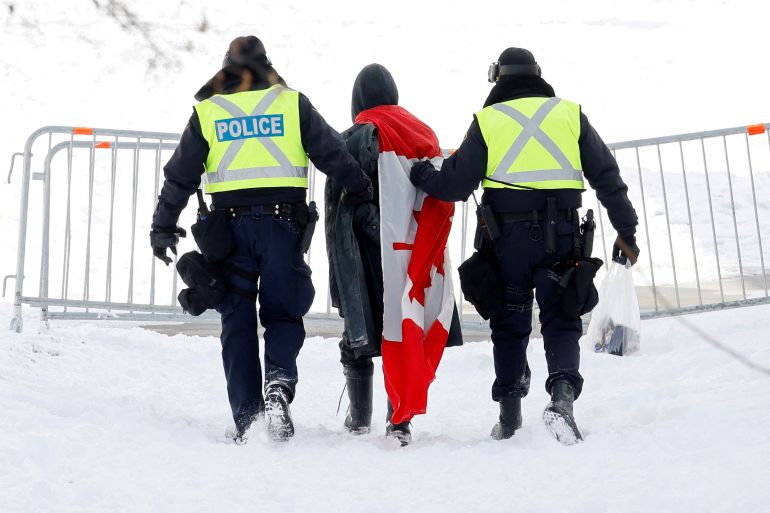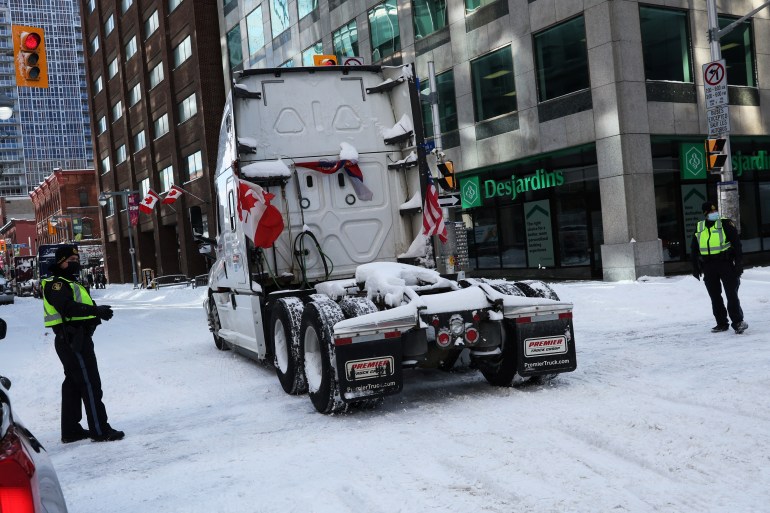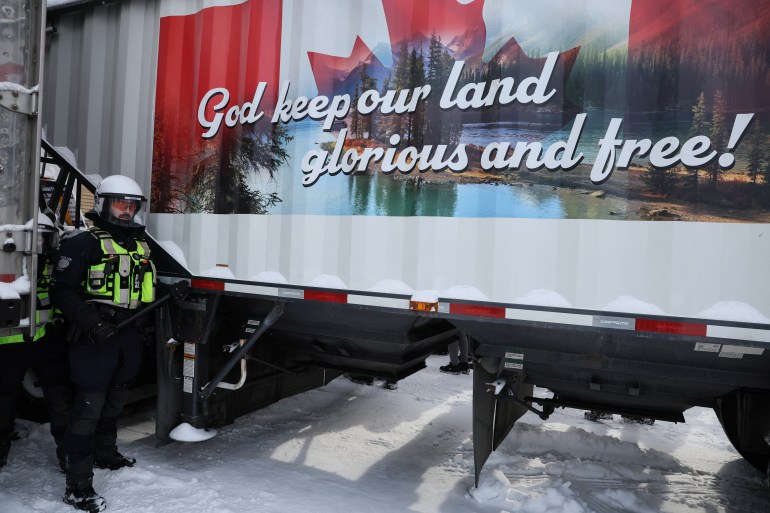What the truckers’ convoy revealed about policing in Canada
Initial hands-off approach to far-right movement reveals double standards and institutional police biases, experts say.

Ottawa, Canada – The occupation of Canada’s capital by the so-called “Freedom Convoy” continues to reverberate, raising questions about pandemic policies, the limits of public protests, and the presence of far-right, white supremacist groups in the country.
It also has spurred an ongoing discussion about the role of police, as many Ottawa residents said they were abandoned amid threats and harassment from convoy participants, who paralysed the city’s downtown core for three weeks.
Keep reading
list of 3 itemsHow Ottawa residents took care of each other when no one else did
Ottawa police chief resigns amid criticism over trucker protests
“This will serve as a catalyst for discussion and debate around the role and function of police, the scope of what they do – as it should,” said Akwasi Owusu-Bempah, a sociology professor at the University of Toronto.
“Had the police taken concerns around right-wing nationalists, white nationalists, more seriously; had they been paying attention to what had been discussed online and previous attempts by some of the organisers to organise similar demonstrations, perhaps this would have been prevented,” he told Al Jazeera.
Police response
The large group of Canadian truckers and their supporters left western Canada for Ottawa in late January, rallying under the “Freedom Convoy” banner in protest of a coronavirus vaccine mandate for truck drivers crossing the Canadian border with the United States.
But very quickly, Canadian media reported that some of the convoy’s main organisers were activists known to have espoused white supremacist views and conspiracy theories. Some were previously involved in right-wing movements, such as Wexit and Yellow Vests Canada.
Some also openly talked about their intention to stay in Ottawa until all their demands – which ranged from lifting all coronavirus curbs in Canada to removing Prime Minister Justin Trudeau’s government from office – were met. “I advocate civil war,” Jim Doerksen, a convoy supporter, told Global News in Saskatoon, Saskatchewan, on January 26, days before the convoy reached the capital. “If people don’t want to stand up, we’ve got guns – we’ll stand up and we’ll bring ’em out.”
Yet despite that, the Ottawa Police Service (OPS) did not stop the demonstrators from driving their big rigs and other large vehicles into the heart of the city. In a series of tweets on January 28, the day the first trucks arrived, OPS said it respected the right to public protest. “We are aware of inappropriate and threatening language on social media related to this event,” the force said. “We encourage demonstrators to focus on delivering their message in a way that is safe for everyone.”
— Ottawa Police (@OttawaPolice) January 28, 2022
Then-Ottawa police chief Peter Sloly said OPS had decided to avoid ticketing and towing vehicles “so as not to instigate confrontations”. As the protesters dug in, setting up camps and running supplies into downtown Ottawa, he told reporters: “There may not be a police solution to this demonstration.”
Sloly resigned from his post on February 15, when the protesters remained embedded in the city’s downtown core. Days later, after Trudeau invoked an emergency measure to bolster support for law enforcement, police moved in to disperse the convoy, arresting nearly 200 people and setting up barricades to prevent them from returning. Residents questioned why it had taken so long.
Institutional problems
Jeffrey Monaghan, associate professor at Carleton University’s Institute for Criminology and Criminal Justice, said the police response to the convoy flipped the typical approach to protest policing on its head. Normally, police spend weeks ahead of major demonstrations warning about potential violence, aiming to delegitimise the movements ahead of time, he said.
“The typical relationship between police and protesters isn’t welcoming, it’s often warning. It’s often creating a public narrative that attempts to undermine political messages by tasking them as violent, especially when you’re talking about Indigenous protesters and Black Lives Matter protests,” Monaghan told Al Jazeera.
But with the convoy “there was kind of a deliberate structure to the narrative that this was a legitimate protest – even though there’s all kinds of evidence that it was going to be a complete s**t-show beforehand,” Monaghan said.
He said there are only two possible reasons for that stark difference: gross incompetence on the part of the police, or police did not want to treat the convoy movement the way they do others “because they share sympathies, and they share similar cultural and political values”.
“Either of those options [is] really not good for advocates of incremental change for policing. It means that there’s a lot of problems institutionally and structurally with policing,” he said.
In that sense, the convoy also may spur a push to defund the police, a call that has gained momentum across Canada and the United States in recent years. Opponents of defunding police often argue against it by saying police are needed in moments of crisis. But during the Ottawa occupation, residents had to take it upon themselves to protect each other in the face of authorities’ inaction.
“The police really allowed themselves to whittle away one of the most publicly acceptable critiques of the defund movement,” Monaghan said.
‘Wake-up call’
For Pam Palmater, a Mi’kmaq lawyer and chair in Indigenous governance at Ryerson University in Toronto, more troubling than the lack of immediate action to disperse the convoy protesters was the support members of various police forces and the Canadian military espoused for them. “This is a huge wake-up call … that white hate groups have become more empowered,” she said.
Palmater told Al Jazeera the police response also demonstrated that decisions over who is policed, and how, are not made equitably. “It’s a huge double-standard, and double-standard doesn’t cut it; it’s direct and blatant racism,” she said, about the difference in tactics used against the convoy protesters – who were predominantly white – versus those used against protesters of colour.
“With Indigenous people, they didn’t pass an emergency measures act … With the Wet’suwet’en, with the Mi’kmaq, they sent in hundreds of heavily-armed RCMP snipers.”
Canadian media reported that several members of the military, as well as various police services, either joined convoy protests, donated to their cause, or expressed public support for the movement.
The Toronto Star reported that officers from the Ottawa, Toronto and Ontario provincial police (OPP) departments donated money to the convoy. A former federal police officer and member of Prime Minister Trudeau’s security detail also acted as head of security for the convoy. Ottawa’s interim Ottawa police chief said this month that “a very, very small number” of OPS officers were being investigated for supporting the convoy.
Asked how many Ontario provincial police officers or employees participated in, donated to, or supported the convoy, an OPP spokesman told Al Jazeera the force was still looking into the matter. “As has been indicated earlier there have been investigations launched into a few separate incidents involving our members,” the spokesman said, without going into further detail. “Any demonstration or expression of views and opinions that may be interpreted as condoning illegal activity is in direct opposition to the OPP’s values and mandate,” the spokesman added.

White supremacy
But the overlap between institutions of power and white nationalism – and the prevalence of far-right and white nationalist views in Canada, more generally – goes deeper and well beyond the convoy alone.
Researchers in 2020 found that (PDF) the number of hate groups operating in the country had tripled in recent years, with anti-Muslim and anti-Trudeau rhetoric the “most salient” topics among right-wing extremists online. That same year, the agency that oversees Canada’s spy agency said in its annual report (PDF) that white supremacy within the Canadian military had been well documented. White supremacist groups both actively seek out people with previous army training and encourage their adherents to enlist to gain access to military tactics and equipment, the report said.
More recently, in August of last year, Global News cited a declassified Canadian intelligence report that warned that “several xenophobic and anti-government/anti-authority violent extremist groups openly recruit current and former military and law enforcement personnel.”
The Ottawa Citizen newspaper first reported that members of an elite anti-terrorism military unit were under investigation for taking part in the convoy protests, while a Canadian army colonel is also being investigated for allegedly participating in the convoy.
In an emailed statement to Al Jazeera, the Canadian military said it was aware of 10 instances in which its members either participated in or donated funds to the convoy. “Investigations/reviews into 9 of these are ongoing, with no set time frame for completion,” it said, adding that at least one person was charged in the military justice system, found guilty and fined $387 ($500 Canadian).
Asked about white supremacy within its ranks, the military said hateful conduct was “completely incompatible” within the Canadian armed forces. It added: “We are committed to eliminating racism, discrimination and hateful conduct and continue to take concrete steps to addressing this issue which harms our people and affects our operational capabilities.”
The way forward
But many Ottawa residents and politicians say a thorough and independent probe into the decisions made during the convoy occupation, which cost the city tens of millions of dollars, is urgently needed – from police to the City of Ottawa, the province of Ontario and the federal government.
The recent resignations of several members of the board that oversees Ottawa police have only spurred that demand. One provincial appointee to the Ottawa Police Services Board is believed to have attended the demonstrations, Canadian media reported. “Not only were they [police] complicit, but many of them supported it,” Sam Hersh, a board member of Horizon Ottawa, a progressive advocacy group in the city, told Al Jazeera.
Trudeau’s use of the Emergencies Act to disperse the convoy requires the federal government to create a special committee to examine “the circumstances that led to the declaration being issued and the measures taken for dealing with the emergency”. That committee was formed this month, and co-chair Matthew Green of the left-leaning New Democrats told CBC News that police actions would be among the key issues investigated.
Ottawa city councillors Catherine McKenney and Jeff Leiper also recently urged the federal government to call for a Royal Commission – an inquiry into matters of national concern – “to explore the convoy in the context of growing far-right extremism and white supremacy both here and abroad”.
Some experts have warned the Ottawa police force could seek to pin everything that went wrong on Sloly, the former police chief, instead of addressing deep-set, structural problems with policing.
Sloly, who is Black, believed in police reform and had recognised systemic racism within the OPS, which lost him support among rank-and-file officers and the city’s hardline police union.

“Police are really using this – their own mismanagement of the crisis – as an excuse to get more resources. They’re saying the reason everything happened in the way that it did is because they didn’t have enough resources. But the real issue obviously is that they let it happen,” Hersh said.
“The way forward is continuing to fight to ensure that the money that’s supposed to go to police goes to those folks who were most affected by this crisis,” he said. “We need to put that funding into social services to help those people, not continue to increase the exorbitant police budget.”